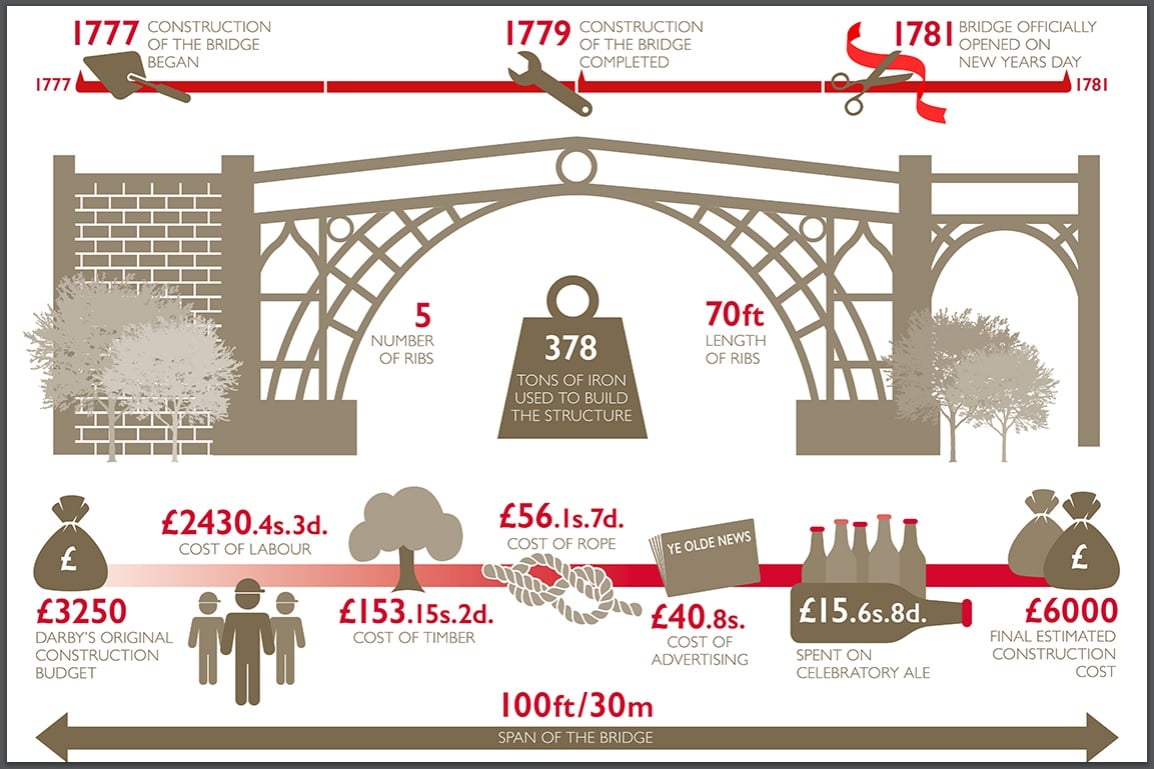Why we love the Iron Bridge
'This graceful structure in its beautiful setting has been a source of endless fascination and has given me a lifetime of study end enjoyment. For the first time cast iron was used structurally and gave such confidence in this previously untried material that many other iron bridges followed,' David de Haan, historian
'The bridge resides in the heart of the Ironbridge Gorge, which is a place that many call home, with many living here for generations keeping the memories and history alive in this unique place,' Nicola Lowery, councillor for Ironbridge Gorge
'After it was built cast iron came to be widely used in bridges, aqueducts and buildings. For me it represents a pivotal moment in development of metallurgic design and engineering,' Morgan Cowles, English Heritage Head of Conservation Maintenance
Plan Your VisitPostcard from the Iron Bridge
Explore the Iron Bridge and follow our drone camera as we weave below and above the magnificent structure.
Take a closer look
It's not just people who have trekked across the Iron Bridge. Take a look at this elephant, who famously marched across the bridge to promote the Chapman's Zoo-Circus in 1932.
As part of its Shropshire tour, the circus performed two shows for five towns across the region. To create buzz around the circus, an elephant dressed in a Chapman's advertising banner, crossed the Iron Bridge on 15 May. Unsurprisingly the stunt attracted a large crowd to marvel at the spectacle. This iconic image of the elephant crossing the bridge remains synonomous with the celebration of the bridge and its strength. Pick up a postcard or print from one of the nearby community outlets.
Discover more historyWhat makes the Iron Bridge special?
As the world's first bridge to be built of cast iron, the Iron Bridge set a new, exciting precendent for engineers around the world. It was 1779 and the surrounding area was a bustling hub of industrial activity at the forefront of what would become known as the Industrial Revolution. The bridge was so successful that it gave its name to the whole Ironbridge Gorge - now a World Heritage Site.
Enjoy views along Britain's longest river, the River Severn, which snakes through the west of England towards the Severn Estuary. Picture what life was like in the Ironbridge Gorge in Shropshire when it was populated by smokey industrial activity more than 200 years ago.
Made from 378 tons of iron, the bridge is a credit to the driving force behind the project, Abraham Darby III. His skill was a family affair, too. In the early 18th century, Darby's grandfather, Abraham Darby I, pioneered an economically viable method for the mass production of iron using coke. This process was a catalyst for the Industrial Revolution. Today you can see the ingenious craftsmanship of the bridge that changed the way iron was used forever.
Three things to look out for
- 'Table of Tolls': Until 1950, everyone crossing the Iron Bridge was required to pay a toll - even kings and queens. Look out for the 'Table of Tolls' sign near the bridge at the Tollhouse, demonstrating that everyone from pigs to members of the Royal Family had to pay their way.
- Views of the Severn: Enjoy views up and down the River Severn from the Iron Bridge, the perfect vantage point. This section of the river is lined by dense woodland and a haven for wildlife.
- The Tollhouse: Visit the original tollhouse, run by the Ironbridge Gorge Museums, on the southern side of the bridge. Explore an exhibition about its history, construction and significance and discover why its considered a symbol of the Industrial Revolution.
Project Iron Bridge: Saving an Industrial Icon
In 2017-18 we undertook a major conservation project to restore the Iron Bridge, due to stresses in the ironwork since its original construction. There has also been disruptive ground movement over the centuries and an earthquake at the end of the 19th century.
We cast more than 300 bespoke iron wedges to replace those which support the deck. A team of six painters then applied 2,400 litres of paint to return to bridge to its original red-brown hue after new evidence came to light during the conservation process.
Without your support this project would not have been possible.
Thank you.
Find out moreMore to explore
-

More spotlights on places we love
Find out more about some of our favourite historic places in England.
-

Travel guide to West Midlands
Plan a short break in the West Midlands with our travel guide.
-

Members do more
Enjoy unlimited days out for a whole year, plus free or discounted entry to a range of events. From just £43.

